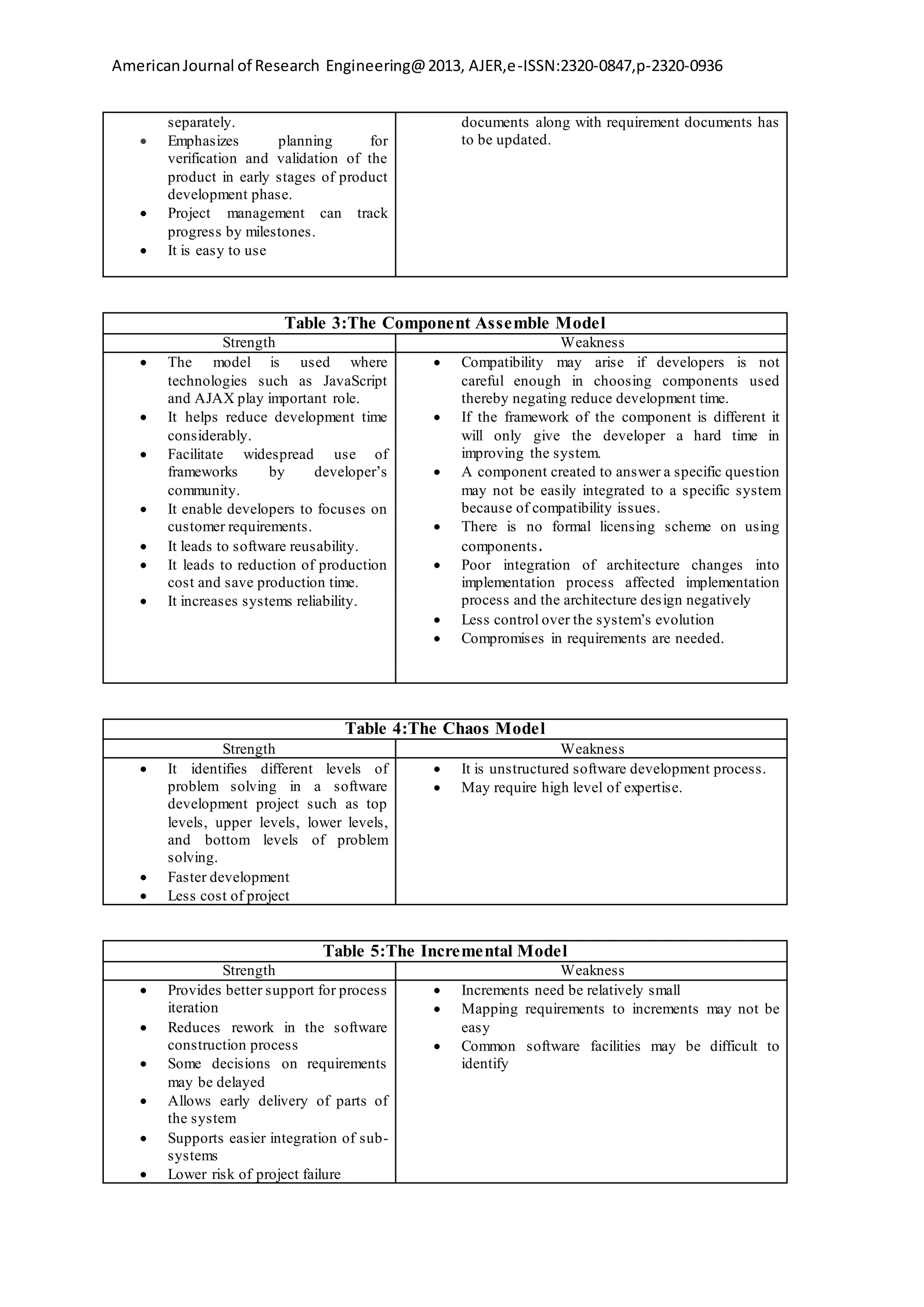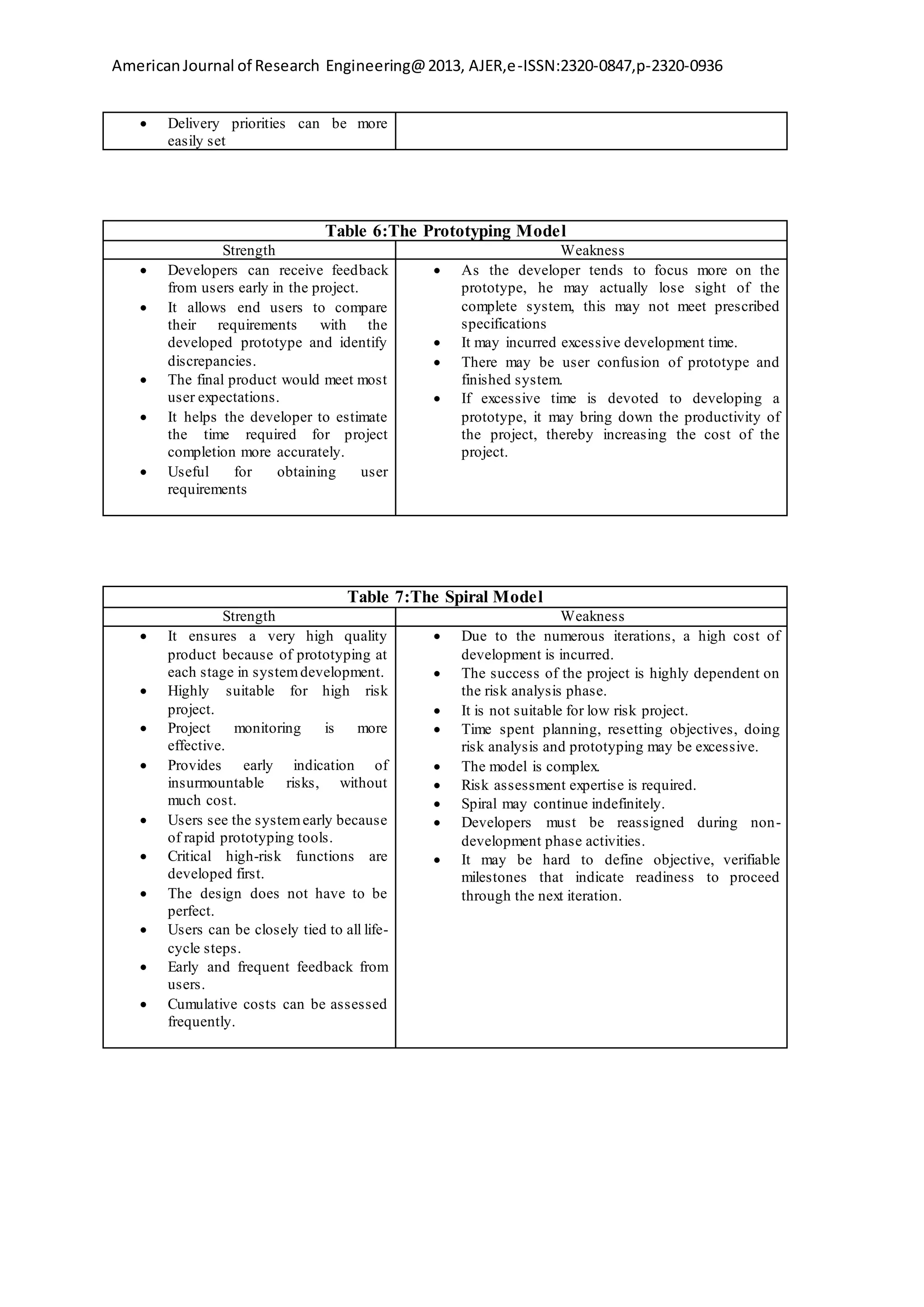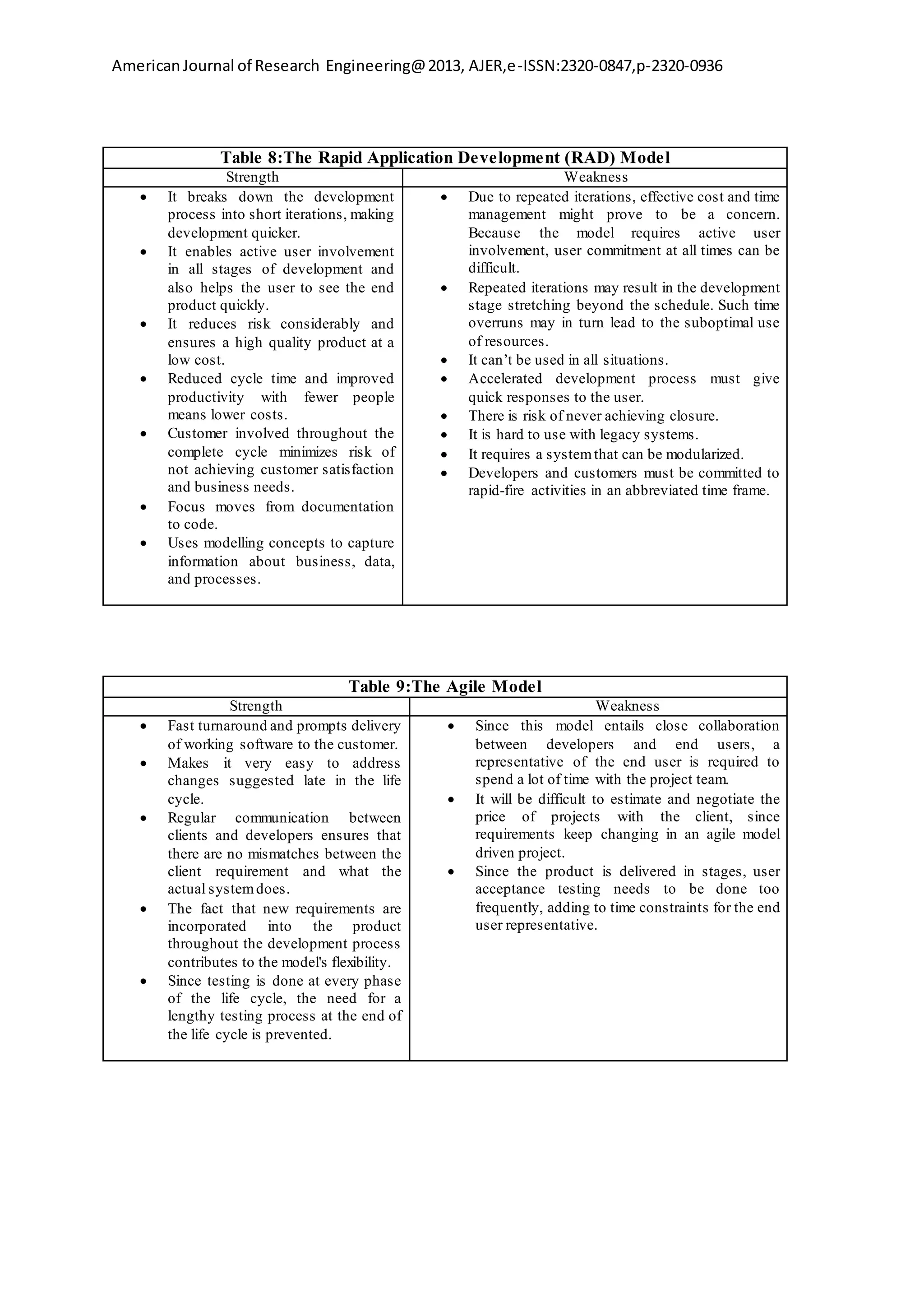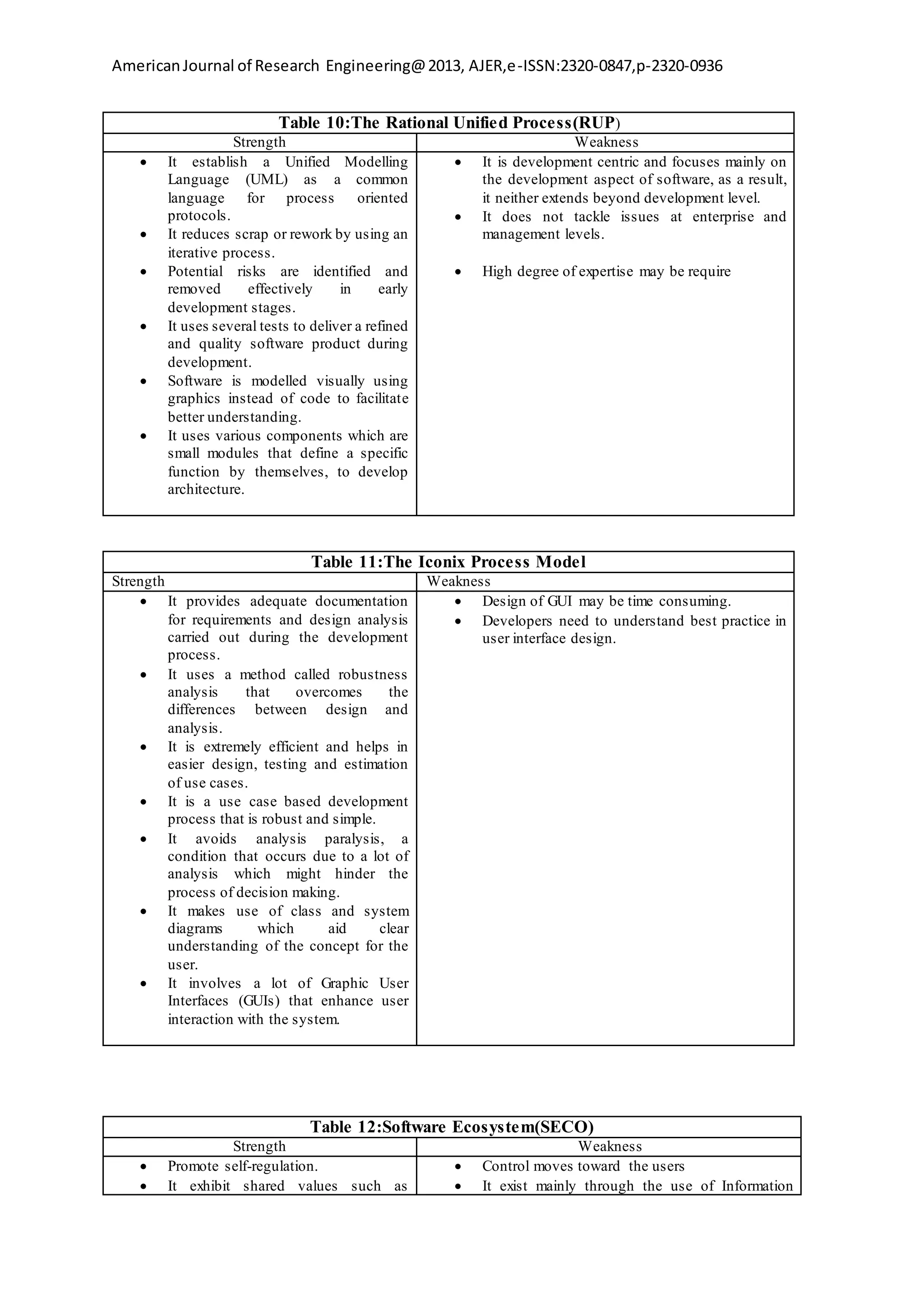This document surveys various software process models used in software development, including the waterfall, v-model, agile, and spiral models, among others, detailing their characteristics, strengths, and weaknesses. It highlights the evolution and purpose of these models in efficiently delivering software projects while accommodating varying degrees of user involvement and flexibility. The study concludes by summarizing the critical aspects of each model to facilitate informed choices in software development practices.
![AmericanJournal of Research Engineering@2013, AJER,e-ISSN:2320-0847,p-2320-0936
A Survey of Software Process Models
J.V. Joshua, S.O. Okolie, O.D. Alao, M.O. Agbaje
Department of ComputerScience, Babcock University,Ilishan-Remo, Ogun State,Nigeria.
ABSRACT – A software Process model is a standardised format for planning, organising, and runninga new
software development project. The need to complete and deliver software projects faster require using a suitable
model.
There are several different kind of models being used which have evolved over the years, in this paper we
carried out survey on the following main types of model; waterfall model, V-model, Component assembly model,
Chaos model, Incremental model, Prototyping model, Spiral model, Rapid application development (RAD)
model, Agile model, rational unified process (RUP), Iconix process and Software ecosystem (SECO) model by
describing their characteristic features.
We concluded the study by listing the strengths and weaknesses of each of this models.
Keywords – Software, Software Process, Software Process Model, Software development
I. Introduction
Software is a major worldwide industry and demand is increasing exponentially [10]; [3]; [13]; [7]; [12].
Software pervades a multitude of products, in social, business and military human-machine systems. It includes
information technology systems, developed for gathering, processing, storing, retrieval and manipulation of
information, to meet organizational needs, and commercially-developed software products, sold to one, or more,
customers or end-users. Software offering functionality to an end-user is also called application software, and
might be a product on its own, or might be embedded in a larger system or machine. Figuratively speaking,
application software sits on top of system software, which are low-level programs, such as operating systems
and utilities for managing computer resources, which interact with the computer at a basic level.
Software Process is an organised set of activities aimed at building a software system. Software Process
Model is an abstract representation of a software process.
There are several software development models employed to develop this solution, some methodologies or
models are suitable for a particular domain.
In the next section, we give an insight to different development models that have evolves over years to the
present.
2. Software Development Models
2.1 Waterfall Model
The waterfall model is one of the earliest models in which phases are executed sequentially. The life cycle of
software development starts with the first stage and moves down through the various stages until the last stage:
implementing the software in a live environment. All stages in the waterfall model are cascaded so that each
stage will start only when all tasks identified in the previous stage are complete as shown in Fig.1. The phases in
the waterfall model do not overlap with each other, thereby making the model quite easy to use.](https://image.slidesharecdn.com/agbaje7surveyofsoftwarprocess-210421114155/75/Agbaje7survey-of-softwar-process-1-2048.jpg)
![AmericanJournal of Research Engineering@2013, AJER,e-ISSN:2320-0847,p-2320-0936
Fig.1. The waterfall model. [17]
2.2 V-Model
The V-model is a software development model in which testing activities are performed in parallel with
development activities. The phases of software development are placed on the left of the V-model and their
corresponding phases of testing are placed on the right. Similar to the waterfall model, in this model, the life
cycle of software starts with the requirement phase, except that an additional plan is created to check that
requirements are gathered properly. This helps to identify any issues in the requirement specification at an early
stage in the development life cycle. Similarly, different test plans are created during all of the phases until the
coding phase before moving on to the next phase.After the coding phase is complete, the cycle goes up the right
side where test plans created earlier are used. Fig.2 below shows the V-model phases.
Fig. 2. The V-model.[1]
2.3 Component Assembly Model
The component assembly model is a unique development model that uses existing components to build a new
system. Instead of writing code from scratch, existing code is analysed to verify whether it can be reused. The
identified components are then integrated into the new system (Fig. 3). This is mainly implemented when
systems are built using object-oriented technologies. These technologies provide the ideal platform for
developing systems using the component assembly model. They also enable you to build object-oriented classes
that can be reused across various systems and applications.](https://image.slidesharecdn.com/agbaje7surveyofsoftwarprocess-210421114155/75/Agbaje7survey-of-softwar-process-2-2048.jpg)
![AmericanJournal of Research Engineering@2013, AJER,e-ISSN:2320-0847,p-2320-0936
Fig. 3 Components from an existing system being reused in a new system. [17]
2.4 Chaos Model
The chaos model is an SDLC model that employs a chaotic and unstructured software development process. It
identifies different levels of problem solving in a software development project such as top levels, upper levels,
lower levels, and bottom levels of problem solving as shown in fig.4. The top levels involve the development
and maintenance of a whole system. The upper levels address the development and maintenance of individual
components. The lower levels focus on the development and maintenance of objects and functions. Finally, the
bottomlevels of problem solving involve the development and maintenance of individual lines of code
Fig. 4 The Chaos Model [15]
2.5 The Incremental Model
The incremental model is a software development model in which individual modules of the system are
developed and integrated in stages as shown in Fig. 5). Integration of two or more components is not dependent
on the rest of the components. In this model, however, modules once developed cannot be modified to
accommodate new requirements. Because modules are viewed independent of one another, feedback for one
module is not implemented in other modules.
Validate
increment
Develop system
increment
Design system
architecture
Integrate
increment
Validate
system
Define outline
requirements
Assign requirements
to increments
System incomplete
Final
system
Fig. 5. Incremental model [17]](https://image.slidesharecdn.com/agbaje7surveyofsoftwarprocess-210421114155/75/Agbaje7survey-of-softwar-process-3-2048.jpg)
![AmericanJournal of Research Engineering@2013, AJER,e-ISSN:2320-0847,p-2320-0936
2.6 Prototyping Model
Software Prototyping is the process of creating a system that is not complete in every respect but bears a
resemblance to the actual system. The incomplete system, called a prototype, typically simulates only certain
features of the actual system and sometimes can even be completely different from the system that will finally
be developed (Fig. 6). The main purpose of prototyping is to allow end users to evaluate the prototypes of the
eventual system. Prototyping provides an opportunity for the end user to list requirements that were not
identified earlier. The many variants of software prototyping include throwaway, evolutionary, incremental, and
extreme prototyping.
Fig. 6. Creation of the prototype of the actual system.[17]
2.7 The Spiral Model
The Spiral Model is an iterative software development model that involves creating an initial prototype of the
final software product, and then carrying out various cycles of adding new functionality and releasing
subsequent prototypes, with the prototype becoming larger with each iteration. It has four phases: planning, risk
analysis, engineering, and evaluation as shown in Fig. 7. One cycle of all four phases executed in sequence is
called a spiral and a prototype is created after the first spiral. This prototype goes through an evaluation process
for assessing its strengths, weaknesses, and risks. After the review of the previous spiral, the next prototype is
built by applying changes or adding new features as suggested by the client. The iteration continues until all of
the requirements are met and the final refined prototype is obtained.
Fig. 7. The spiral Model. [3]
2.8 The Rapid Application Model (RAD) Model
Rapid Application Development (RAD) is a software development model that uses iterations for software
development. It operates by building prototypes at the end of each iteration using automated tools that help not
only to expedite software development but also to ensure the highest quality of the software developed. It
compresses the linear steps in traditional models into short iterations during development (Fig. 8). It is flexible,](https://image.slidesharecdn.com/agbaje7surveyofsoftwarprocess-210421114155/75/Agbaje7survey-of-softwar-process-4-2048.jpg)
![AmericanJournal of Research Engineering@2013, AJER,e-ISSN:2320-0847,p-2320-0936
produces fewer errors, and involves users at every stage of development. The downside to this model is that it is
not suitable for every single project because it compromises on some of the features needed in large, mission-
critical projects. RAD is extensively used in projects with low scope and for tasks that can be broken down into
smaller chunks.
Fig. 8. The RAD model. [14]
2.9 The Agile Model
The Agile Model is a software development methodology that is based on iterative development, wherein teams
collaboratively work to implement various iterations in a project life cycle [5]. It divides project tasks into small
increments, and therefore involves only short-term planning. Each iteration consists of several phases, each of
which is completed in a short span of time ranging between one and four weeks. A complete project will consist
of a large number of these iterations as indicated in Fig. 9. At the end of each iteration, a functional, usable piece
of software is produced. At the core of its superiority over the other models lies its flexibility to incorporate
customer’s feedback right after an acceptance walkthrough of an increment, minimizing overall risks. A generic
agile model is composed of six phases: iteration-1, iteration-0, construction, release, production, and retirement.
Fig.9. The Agile model. [6].
2.10 The Rational Unified Process (RUP) Model
The Rational Unified Process (RUP) is an adaptable software development process used by both large
organizations and small teams to develop software. It is a form of iterative development process that can be
varied to suit the requirements of the organization where it is implemented. RUP mainly uses tools to create
models of software being developed, sparing developers the trouble of documenting the development on paper.
RUP's life cycle consists of four consecutive phases: inception, elaboration, construction, and transition as
shown in fig. 10. In the inception phase, the concept behind the process is reiterated and the boundaries of the
project are defined. In the elaboration phase, the problem domain is identified and architecture established. In
the construction phase, the software is developed. Finally, in the transition phase, the product is sent to the user
domain.](https://image.slidesharecdn.com/agbaje7surveyofsoftwarprocess-210421114155/75/Agbaje7survey-of-softwar-process-5-2048.jpg)
![AmericanJournal of Research Engineering@2013, AJER,e-ISSN:2320-0847,p-2320-0936
Fig. 10. The various phases in RUP. [16]
2.11 The Iconix Process Model
Iconix is a software development process that is mainly concerned with use case development process. Use
cases are interactions that are recorded between the user and the system as shown in fig. 11. The Iconixprocess
provides adequate documentation for requirements and design analysis carried out during the development
process.It uses a method called robustness analysis that overcomes the differences between design and analysis.
It is extremely efficient and helps in easier design, testing and estimation of use cases. The Iconix process
consists of four phases: Requirements, Preliminary Analysis, Detailed Design, and Implementation.
Fig. 11. The features of iconix process [8]
2.12 The Software Ecosystem(SECO) Model
A Software Ecosystem consists of set of software solutions that enables supports and automates the activities
and transactions by the actors in the associated social or business ecosystemand the organizations that provide
these solutions [4]. Fig. 12 illustrates the main actors in a Software Ecosystem Model. The supplier (keystone
organization) develops the product line. This development is guided by a strategy, which points out needs and
opportunities and main paths of development. Both the strategy and the development of the product line
are to some extent visible to external actors. These consist of (at least) customers and third parties, but can
also involve others such as suppliers. Third parties use the product line as a platform to serve customers with
additional solutions and services. Being a part of an ecosystem means that these actors learn about each other.
The supplier learns about requirements, needs, ideas, opportunities, and others. In re t u rn , external actors
learn about the development of the technology of common interest (the product line), and may even participate
actively in the development.](https://image.slidesharecdn.com/agbaje7surveyofsoftwarprocess-210421114155/75/Agbaje7survey-of-softwar-process-6-2048.jpg)
![AmericanJournal of Research Engineering@2013, AJER,e-ISSN:2320-0847,p-2320-0936
Fig. 12. A conceptual model of a software ecosystem[9]
3. Results
The tables below summarises the strengths and weaknesses of each of the models describe in this study.
Table 1:The Waterfall Model
Strength Weakness
Planning and scheduling can be
done quite easily
The start time and the completion
time of each phase can be clearly
defined.
The system requirements are
identified long before
programming begins.
Changes to the requirements are
minimised as the project
proceeds.
Highly visible
Project monitoring is easy.
The scope for revising the system is limited
because we do not go back to a phase once it is
completed.
It suffers lack of flexibility because once
requirements are collected and the system moves
on to the next phase, additions to the requirements
are not possible.
New requirements has to be incorporated on to the
next version once requirements is not capture at
requirement phase therefore leading to project cost
and affecting profitability.
Freezing the specification is difficult
Table 2:The V Model
Strength Weakness
It allows planning to be done quite
early in the System Development
Life Cycle (SDLC) before
performing the testing.
It is less complex and easier to use
and manage because test planning
is involved very early in the SDLC
Each phase has a specific
deliverable, so it can be analysed
The non-availability of a prototype until the
implementation phase is complete.
It does not easily handle concurrent events.
It does not contain risk analysis activities.
Very rigid and least flexible.
Software is developed during the implementation
phase, so no early prototypes of the software are
produced.
If any changes happen in midway, then the test](https://image.slidesharecdn.com/agbaje7surveyofsoftwarprocess-210421114155/75/Agbaje7survey-of-softwar-process-7-2048.jpg)




![AmericanJournal of Research Engineering@2013, AJER,e-ISSN:2320-0847,p-2320-0936
revenue from licenses and services.
It comprises network of characters –
vendors, developers and users.
It increases visibility
Increases extensibility.
It attracts mass following.
communication Technology (ICT).
It is more complex, hence effective management
may be a key issues.
It may not be very successful in a closed system.
4. Conclusion
This paper exposed the characteristics features of major software development models and try to identify the
merits and drawbacks of each of this models.
From the study, software process models can be categorised into three main types’ namely incremental model,
iterative model and sequential model, some model are hybrid of two or more models.
This study will assist practitioners in making choice of the best development model to adopt in software
development project they may be undertaken.
However, there is a paradigm shift to a new emerging development model call software ecosystem (SECO)
model, but the software industry is still elucidating to understand this concept, but literatures shows that
software development process is moving toward this concept.
References
[1] Andrew Ratcliffe (2011) SAS Software Development with the V-Model, Ratcliffe Technical Services
Limited (RTSL).eu, United Kingdom.
[2] Boehm, B.W., (1988). “A Spiral Model of Software Development and Enhancement.” IEEE Computer.
[3] Boehm, B.W., Sullivan, K.J., “Software Economics: A Roadmap”, ACM Press, 2000.
[4] Bosch, J. (2009). From Software Product Lines to Software Ecosystems. In proceedings of 13th
International Software Product Line Conference (SPLC'09), San Francisco, USA, 24-28 August. 111-119.
[5] Dybå, T., and Dingsoyr, T., (2008), ‘Empirical Studies of Agile Software Development: A Systematic Review’. Information and
Software Technology, 50, n.9-10, 833-859, August.
[6] Cockburn, A. (2002). Agile Software Development. Boston: Addison-Wesley.
[7] Fuggetta, A. (2000), “Software Process: A Roadmap”, in “The Future of Software Engineering”, ACM Press.
[8] Gomaa H. (2004) DesigningSoftware Product Lines with UML: From Use Cases to Pattern-Based Software Architectures. Addison
Wesley.
[9] Hanssen, G. (2011). A Longitudinal Case Study of an EmergingSoftware Ecosystem. Acceptedfor publicationin Journal of Systems
and Software, pages 1–24.
[10] Hoch, D.J, et al., “Secrets of Software Success: Management Insights from100SoftwareFirms Aroundthe World”, Harvard Business
Scoll Press, Boston, MA, 1999.
[11] Humphrey, W.S. (2001), “The Future of Software Engineering: I”, Column SEI, Vol. 4 (1), 2001.
[12] Humphrey, W.S. (2002), “Winning with Software: An Executive Strategy”, Addison-Wesley, 2002
[13] Littlewood, B., Strigini, L. (2000), “Software Reliability and Dependability: a Roadmap”,
Proceedings of the 22nd International Conference on Software Engineering.
[14] Pressman, R., S. (2001) Software Engineering: A Practitioner’s Approach, 5th Edition. McGraw-Hill International edition.
[15] Raccoon L. B. S (1994), Albuquerque, New Mexico
[16] Jacobson Ivar, Grady Booch, and Jim Rumbaugh (1999). Unified Software Development Process, Addison-Wesley.
[17] Sommerville Ian (2010). Software engineering 8th
. Edition. Pearson Addison-Wesley.](https://image.slidesharecdn.com/agbaje7surveyofsoftwarprocess-210421114155/75/Agbaje7survey-of-softwar-process-12-2048.jpg)